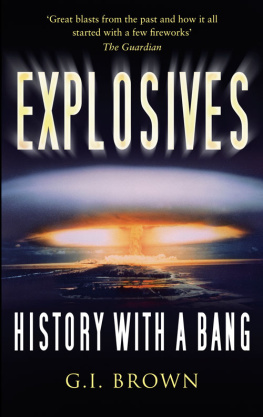
For Barbara, Helen and Louise
The author would like to thank the following individuals and organizations for their help:
Argonne National Laboratory, USA; BASF; British Museum; Calladines (Stationery), Eton; Chemistry in Britain (The Royal Society of Chemistry); the librarian of Christ Church College, Oxford; Compair Holman Ltd; DuPont (UK) Ltd; Eley Hawk Ltd; the librarians of Eton College; Explosive Storage and Transport Committee of the Ministry of Defence; Faversham Society, Kent; Federation of Demolition Contractors; Greater Manchester County Record Office; Hagley Museum and Library, USA; Health and Safety Laboratory (Explosives Section), Buxton; Peter Huggins, ICI; ICI Australia Operations Pty Ltd; Imperial War Museum; Italesplosivi, Milan, Italy; Julian Cleeton; G.N.G. Tingey; Los Alamos National Laboratory, USA; National Maritime Museum; National Railway Museum; Oxford University Press; The Patent Office; Quarry Products Association; Robinson & Birdsell Ltd, Leeds; Royal Air Force Museum, Hendon; Royal Armouries, Leeds; Royal Artillery Historical Trust; Royal Collection Enterprises; Royal Commission on the Ancient and Historical Monuments of Scotland (RCAHMS); and the librarians of the Science Museum.
He is also grateful for help from Anne Marshall, Adam Hart-Davis and John Briscoe; to a number of friends who read the manuscript in its early days; and to his patient wife. She was a constant source of encouragement and provided both historical background and useful reminders when the technical matters became too much for her.
C ONVERSION F ACTORS
1 millimetre (mm) | = 0.039 inch |
1 metre (m) | = 1000 mm
= 39.37 inch | = 1.094 yard | = 3.2808 feet |
1 kilometre (km) | = 1000 m
= 3280.8 feet | = 0.621 mile | = 1093.6 yard |
1 gram (g) | = 0.035 ounce |
1 kilogram (kg) | = 1000 g | = 2.205 pound | = 35.274 ounce |
1 Megagram (Mg) | = 1000 kg
= 2204.6 pound | = 1 tonne | = 0.984 ton |
1 atmosphere (atm) = 101,325 Pascal (Pa) = 14.7 pound per square inch |
Contents
and Conversion Factors
When George Brown sent me the typescript of this book, my heart sank a little.I had plenty of work to do at the time, and the thought of having to read a treatise on the history of explosives filled me with gloom. However, feeling I should be polite, I started reluctantly at page 1 and by page 3 found I was utterly hooked. I wont say I couldnt put it down, because in fact it was in a huge ring-binder that was so heavy I could scarcely pick it up, but I found the book completely fascinating. I read it right through, and now wait impatiently for a bound copy to read again, with all the excellent illustrations in place.
The first few pages give a fine flavour of The Big Bang, with the intriguing story of Greek fire, and how it was ousted by the new-fangled gunpowder. The struggles of so many people to make good gunpowder, the secret code of Roger Bacon, and the enigma of Black Berthold Schwartz had me on the edge of my seat.
I present a television series called Local Heroes, which celebrates pioneers of science, technology and invention, so I am always interested in stories about how people have ideas and introduce new technology. The Big Bang is full of such stories: in particular I recommend those of Bickford, Forsyth and Congreve. William Bickford, a Cornish currier in Tuckingmill, was so distressed by seeing the results of accidents with blasting powder in mines that he invented the safety fuse, which has scarcely changed till this day. Scottish minister Alexander Forsyth was frustrated when he tried to shoot ducks on the loch near his house at Belhevie north of Aberdeen, because the ducks saw the flash in the pan of his flintlock gun and flew away before the shot arrived; so he invented the percussion cap, which transformed military guns. Yet neither of these two made any money before they died. Colonel Sir William Congreve, by contrast, was much more successful with his rockets even though they were more effective at terrifying horses than at damaging the enemy. However, he did manage to set fire to Boulogne by mistake, and his rockets blazed their way into the American National Anthem.
George Brown has done an exceptional job of weaving together the strands of history, biography, politics and science. I was fascinated to learn about the du Ponts, Alfred Nobel and Robert Oppenheimer; about Guy Fawkes and the Gunpowder Plot, about Count von Rumford and his extraordinary love-life, and about Chaim Weizmann and the national conker collection. I am most grateful to George for bringing these stories to my attention, and I hope you too will enjoy this splendid book.
Adam Hart-Davis
May 1998
CHAPTER 1
Fire can cause so much damage and create so much confusion, chaos and terror that it is not surprising that the use of incendiaries in warfare dates back to very ancient times. Fire-pots being thrown down on troops besieging a town are depicted in Assyrian bas-reliefs in the British Museum, dated around 900 BC , and early writers give detailed, and sometimes lurid, accounts of the use of incendiaries. Herodotus describes how arrows tipped with burning tow were used in the capture of Athens in 480 BC , and Thucydides tells how a huge bonfire was lit against the wooden walls of Platea
They took a great beam, sawed it in two parts, both of which they completely hollowed out, and then fitted the two parts closely together again, as in the joints of a pipe. A cauldron was then attached with chains to one end of the beam, and an iron tube, curving down into the cauldron, was inserted through the hollow part of the beam. Much of the surface of the beam itself was plated with iron When this machine was brought up close to the city wall, they inserted into their end of the beam large bellows and blew through them. The blast, confined inside the tube, went straight into the cauldron which was filled with lighted coals, sulphur and pitch. A great flame was produced which set fire to the wall and made it impossible for the defenders to stay at their posts. They abandoned their positions and fled; and so the fortification was captured.
At first, almost any locally available materials which would burn were used as fuel but, with time, an unusual degree of sophistication crept in. A collection of supposedly contemporary recipes, by taking petroleum, liquid pitch, and oil of sulphur. Put all these in a pottery jar buried in horse manure for fifteen days. Take it out and smear with it crows which can be flown against the tents of the enemy. When the sun rises and before the heat has melted it the mixture will inflame. But we advise that it should be used before sunrise or after sunset. In Arabian manuscripts, the unfortunate crows were apparently set on fire before launching; similar use of fire-birds appears in early Chinese works.
There were many other horrible formulations, all trying to outburn the others, but the use of incendiary materials entered a new phase in AD 673 when an architect called Kallinikos carried the secret of Greek fire from Heliopolis to Constantinople. That majestic city was the centre of the Byzantine Empire and Greek fire was to be the lynch-pin of the empires successful defence, against attacks from all quarters, for the next 800 years. It was an embryonic napalm, the Palladium of the Empire and, without doubt, the greatest deterrent of the day.
Next page















